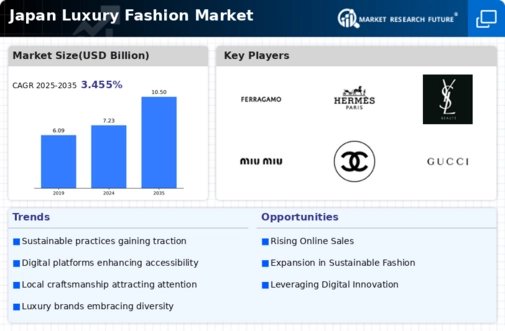The luxury fashion market in Japan is characterized by a dynamic competitive landscape, driven by a blend of traditional craftsmanship and modern consumer expectations. Key players such as LVMH (FR), Kering (FR), and Gucci (IT) are actively shaping the market through innovative strategies and regional adaptations. LVMH (FR) continues to leverage its extensive portfolio, focusing on brand diversification and digital engagement, while Kering (FR) emphasizes sustainability and ethical practices, appealing to the increasingly conscious consumer. Gucci (IT), on the other hand, has been at the forefront of digital transformation, utilizing social media and e-commerce to enhance customer interaction and brand loyalty. Collectively, these strategies contribute to a competitive environment that is both concentrated and fragmented, with established brands vying for market share against emerging players.
In terms of business tactics, companies are increasingly localizing manufacturing to reduce lead times and enhance supply chain efficiency. This approach not only caters to the unique preferences of Japanese consumers but also aligns with global trends towards sustainability. The market structure appears moderately fragmented, with a few dominant players holding substantial market shares while numerous smaller brands carve out niche segments. The collective influence of these key players fosters a competitive atmosphere that encourages innovation and responsiveness to consumer demands.
In September 2025, Kering (FR) announced a partnership with a leading Japanese textile manufacturer to develop sustainable materials for its luxury brands. This strategic move underscores Kering's commitment to sustainability and positions it favorably within a market increasingly driven by eco-conscious consumerism. By integrating local expertise in textile production, Kering not only enhances its supply chain resilience but also strengthens its brand image among Japanese consumers who prioritize sustainability.
In October 2025, Gucci (IT) launched an exclusive digital collection in collaboration with a popular Japanese artist, aiming to tap into the local art scene and attract younger consumers. This initiative highlights Gucci's strategy of blending art and fashion, thereby creating unique offerings that resonate with the cultural fabric of Japan. Such collaborations are likely to enhance brand visibility and foster deeper connections with the local market, reflecting a broader trend of cultural integration in luxury fashion.
In November 2025, LVMH (FR) unveiled a new flagship store in Tokyo, designed to provide an immersive shopping experience that combines physical and digital elements. This investment not only signifies LVMH's confidence in the Japanese market but also illustrates a shift towards experiential retail, where consumers seek more than just products. The store's design incorporates advanced technology, suggesting that LVMH is keen on setting new standards in luxury retailing, which may influence competitors to follow suit.
As of November 2025, the luxury fashion market is witnessing a pronounced shift towards digitalization, sustainability, and the integration of artificial intelligence in consumer engagement strategies. Strategic alliances, such as those between brands and local artisans or technology firms, are increasingly shaping the competitive landscape. Looking ahead, differentiation in this market is likely to evolve from traditional price competition to a focus on innovation, technological advancements, and supply chain reliability. The emphasis on unique consumer experiences and sustainable practices will likely define the future trajectory of competition in the luxury fashion sector.

























Leave a Comment